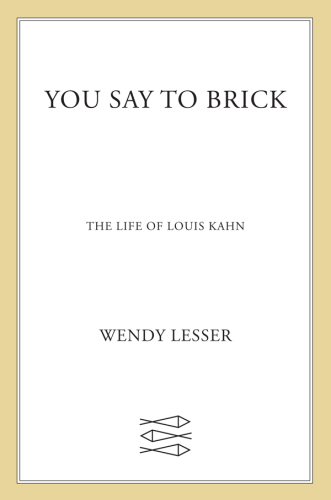
You Say to Brick
The Life of Louis Kahn
کتاب های مرتبط
- اطلاعات
- نقد و بررسی
- دیدگاه کاربران
نقد و بررسی

September 19, 2016
Lesser (Why I Read) doesn’t merely chronicle the life of Louis Kahn, who came to America from Estonia with his impoverished family and gradually
muscled his way into the pantheon of the 20th century’s most celebrated architects. She also manages to let the reader vicariously experience Kahn’s architecture, interspersing this biography with elegant vignettes in which she walks through his most iconic structures. Her enthusiasm for Kahn’s architecture is infectious. Kahn began his professional career designing housing for destitute workers during the Great Depression, and his subsequent architecture projects (always public: museums, churches, libraries, and government buildings) were invariably designed in the egalitarian spirit of bringing beauty to all social classes. These palatial concrete structures were unmistakably modern, but they nevertheless owed much to Roman architecture, and, like the Colosseum, utilize natural light as a nearly palpable architectural element. Lesser breaks from a chronological narrative, instead beginning with Kahn’s death and ending with his childhood, where she finally divulges the story behind the scars that so cruelly marked Kahn’s face. Exhaustively researched and poetically written, Lesser’s book offers a fitting and eminently accessible tribute to an architect who so ardently sought to bring beauty to the public square. B&w photos.

Starred review from December 15, 2016
A new, in-depth biography of the noted American architect. Threepenny Review founder and editor Lesser (Why I Read: The Serious Pleasure of Books, 2014, etc.) begins her stellar biography at the end, with Kahn's death (1901-1974). At the time, the renowned architect, who was "famous for his energy," was "tired." He had just returned from a long overseas trip and had a heart attack in Penn Station in New York. Lesser describes Kahn as "affable, conciliatory, and a bit self-mocking," warm and captivating but secretive (he had two affairs while married). His output was small, but his best buildings were "beautiful in a surprising new way." Kahn came to America from Estonia in 1906 when he was 5, his young face and hands scarred from a fiery accident. Always a brilliant drawer (he was ambidextrous), he received a good education and graduated from the University of Pennsylvania in 1924. In 1935, he worked on a new workers' housing project in Washington, D.C., and soon started his own firm. In 1954, "I discovered myself after designing that little concrete-block bath house in Trenton." Concrete and brick would forever be his favorite construction materials. Lesser punctuates the narrative with five lengthy sections of " 'in situ' descriptions of what it feels like to move through his built structures." The author visited them all. Included are the Salk Institute in San Diego (1959), with its enormous, distinctive plaza. It would be the "only profitable project that Kahn ever undertook." Also included is his "most supremely beautiful accomplishment," the National Assembly Building in Dhaka, Bangladesh, which was the biggest project he ever took on and "in many ways the most difficult." Extensively researched, the book is full of quotes from letters and interviews, providing an intimate portrait of his personality and genius. A splendid biography that penetrates the inner lives of Kahn's buildings as well as the inner life of their creator.
COPYRIGHT(2016) Kirkus Reviews, ALL RIGHTS RESERVED.

November 1, 2016
Founder and editor of the Threepenny Review, with nonfiction that ranges widely through art, literature, and music, Lesser takes apart the life and work of renowned architect Louis Kahn brick by brick, uncovering the true individual beneath a warm but protective exterior. Kahn, the creator of buildings such as schools, museums, and libraries, is shown to be first and foremost a "public" architect.
Copyright 2016 School Library Journal, LLC Used with permission.

February 1, 2017
There are many books about Philadelphia-based architect Louis Kahn (1901-74) and his works. Lesser, a novelist and critic (Music for Silenced Voices) has written a clear-eyed biography of this fascinating man who produced some great architecture. The outline of Kahn's life is known, so for this portrait, the author interviewed family members, employees, clients, colleagues, and friends to gain deeper insights. She toured his most famous works to consult with users and record personal impressions. Injured and sickly as a child, Kahn became something of a visual arts prodigy. One of Lesser's points is that he always practiced as a dedicated artist rather than a businessman of design. He worked very hard, charmed clients with his philosophy, and delivered iconic spatial solutions. However, most of his buildings were completed late and over budget. This book also tracks the architect's studio leadership and his unorthodox family life; he comes across as flawed yet beloved. When Kahn died suddenly, associates stepped in to complete unfinished projects as he would have wished. VERDICT Lesser's treatment humanizes Kahn by highlighting motivation, struggles, and failures that ultimately helped to inform his masterpieces. This biography will appeal to readers with an interest in 20th-century design and culture.[See Prepub Alert, 10/3/16.]--David R. Conn, formerly with Surrey Libs., BC
Copyright 2017 Library Journal, LLC Used with permission.




















![Design Like You Give a Damn [2]](https://dl.bookem.ir/thumbnails/150/ISBN13/9781613122860.jpg)




دیدگاه کاربران